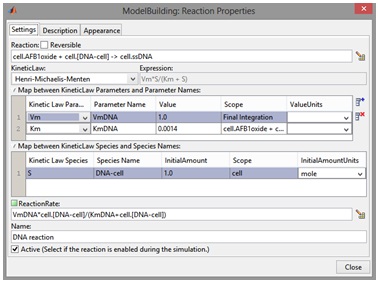Team:ITB Indonesia/Modeling/DNA damage kinetic
From 2013.igem.org
(Created page with "{{:Team:ITB_Indonesia/template/header}} <html> <div id="main"> <div class="content-left"> <div class="post post-single"> <h2 class="title">DNA Damage Kinetic</...") |
|||
| Line 9: | Line 9: | ||
<!-- Masukkan Data Artikel Disini --> | <!-- Masukkan Data Artikel Disini --> | ||
<p>Interestingly, AFB1 oxide is not a stable substance. AFB1 oxide will going through two possible reaction : spontaneous reaction with H2O to produce a more stable and harmless AFB diol, or reacting with N7-Guanine to produce AFB-DNA adduct and damaging cell’s DNA. <br /> | <p>Interestingly, AFB1 oxide is not a stable substance. AFB1 oxide will going through two possible reaction : spontaneous reaction with H2O to produce a more stable and harmless AFB diol, or reacting with N7-Guanine to produce AFB-DNA adduct and damaging cell’s DNA. <br /> | ||
| - | <img src=" | + | <img src="https://static.igem.org/mediawiki/igem.org/6/6e/2013_ITB_Indonesia-dnadam1.jpg" /><br /> |
Mathematical representation of this phenomena can be described by :<br /> | Mathematical representation of this phenomena can be described by :<br /> | ||
| - | <img src=" | + | <img src="https://static.igem.org/mediawiki/igem.org/c/c6/2013_ITB_Indonesia-dnadam2.jpg" /></p> |
| - | + | ||
<p><br /> | <p><br /> | ||
Parameters for DNA damage kinetic are :</p> | Parameters for DNA damage kinetic are :</p> | ||
| Line 42: | Line 41: | ||
<div> | <div> | ||
<p style="border:solid #F60">In this model, we decide to assume that AFB1oxide is “enzyme” and DNA is “substrate”. Here is the parameter we input to Simbiology to simulate this model :<br /> | <p style="border:solid #F60">In this model, we decide to assume that AFB1oxide is “enzyme” and DNA is “substrate”. Here is the parameter we input to Simbiology to simulate this model :<br /> | ||
| - | <img src=" | + | <img src="https://static.igem.org/mediawiki/igem.org/0/06/2013_ITB_Indonesia-dnadam3.jpg" /><br /> |
Notice that we state DNA as the substrate for Michaelis Menten equation.</p> | Notice that we state DNA as the substrate for Michaelis Menten equation.</p> | ||
</div> | </div> | ||
Latest revision as of 03:07, 28 September 2013

DNA Damage Kinetic
Interestingly, AFB1 oxide is not a stable substance. AFB1 oxide will going through two possible reaction : spontaneous reaction with H2O to produce a more stable and harmless AFB diol, or reacting with N7-Guanine to produce AFB-DNA adduct and damaging cell’s DNA.

Mathematical representation of this phenomena can be described by :

Parameters for DNA damage kinetic are :
| Parameter | Value |
Source |
k0 |
0,6 s-1 |
[1] |
Kd |
0,43 mg/ml |
[1] |
kcat |
35 s-1 |
[1] |
We have a problem understanding the unit of Kd (equilibrium constant for bind and unbind of AFB and DNA) because it said mg/ml. So, we hypothetize that the reaction between AFB1oxide and DNA can be assumed like enzymatic reaction (reaction equation of DNA-AFB1oxide is analogous to Michaelis-Menten kinetic), so unit on the left side will agree with the right side of the reaction.
In this model, we decide to assume that AFB1oxide is “enzyme” and DNA is “substrate”. Here is the parameter we input to Simbiology to simulate this model :

Notice that we state DNA as the substrate for Michaelis Menten equation.
Reference :
[1] Johnson, W. W., Guengerich, F. P. Reaction of aflatoxin B1 exo-8,9-epoxide with DNA: Kinetic analysis of covalent binding and DNA-induced hydrolysis.
 "
"